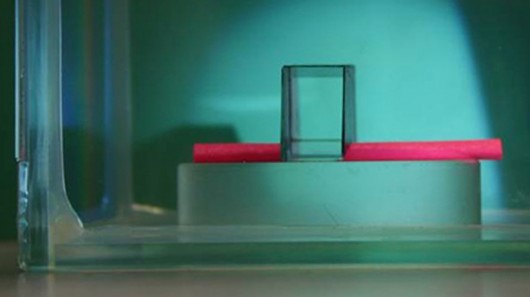'Invisibility cloak' hides objects without using metamaterials
By Darren Quick
21:21 February 3, 2011

Part of the pink object is rendered invisbile to the naked eye under the calcite-based invisibility cloak (Image: Baile Zhang and G. Barbastathis/SMART Centre)
The quest to build a working “invisibility cloak” generally focuses on the use of metamaterials – artificially engineered materials with a negative refractive index that have already been used to render microscopic objects invisible in specific wavelengths of light. Now, using naturally occurring crystals rather than metamaterials, two research teams working independently have demonstrated technology that can cloak larger objects in the broad range of wavelengths visible to the human eye.
Both teams, one from the Singapore-MIT Alliance for Research and Technology (SMART Centre) and the other comprised of researchers from the University of Birmingham, Imperial College, London and Technical University of Denmark, made the breakthrough using a natural crystal called calcite.
This transparent mineral boasts an optical property known as birefringence, or double-refraction. This means that when light enters the calcite, it splits into two rays of different polarizations traveling at different speeds and in different directions. This causes objects viewed through a clear piece of calcite to appear doubled.
To create their invisibility cloak, the University of Birmingham team glued two pieces of calcite with differing optical paths together and placed them on a mirror and performed demonstrations in both air and a container of liquid.
Meanwhile, the SMART Centre team used a similar method. They glued together two pieces of calcite to form a small wedge measuring 38mm x 10mm x 2mm and is placed over an intended object. Due to the light bending as it enters the cloak, objects are rendered invisible when the viewer looks from the left and right sides of the wedge, meaning it remains visible when viewed from other angles.
Although currently the cloaks can hide only small objects, such as a pin or paperclip, the technology is limited only by the size of the calcite crystal.
‘‘This is a huge step forward as, for the first time, the cloaking area is rendered at a size that is big enough for the observer to ‘see’ the invisible object with the naked eye,” said Dr Shuang Zhang, lead investigator from the University of Birmingham’s School of Physics and Astronomy. “We believe that by using calcite, we can start to develop a cloak of significant size that will open avenues for future applications of cloaking devices.”
Additionally, the calcite-based cloaks are much cheaper to create than those using metamaterials. The cloak developed by the SMART Centre team costs less than $US1,000, which is extraordinarily cheap by research standards.
The SMART Centre team’s research was published in Physical Review Letters on January 18, while the University of Birmingham team’s research was published in the journal Nature Communications on February 1.
Copyright © gizmag 2003 - 2010 To subscribe or visit go to: http://www.gizmag.com
